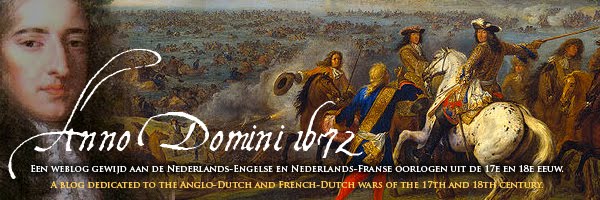
Een gedeelte van het schilderij van de belegering door de Staatsen van de door Bernard van Galen veroverde stad Coevorden. Het schilderij is gemaakt door Pieter Wouwerman in de periode 1672-1682. Uitgelicht de vaandels van het Regiment Rabenhaupt. Het regiment werd in 1595 gesticht onder de naam Nassau-Stad en Lande. In 1620 werd de officiële benaming gewijzigd in Oranje-Stad en Lande om van 1625 tot 1633 weer Nassau-Stad en Lande te worden. Daarna wordt het genoemd naar zijn commandant, met uitzondering van de jaren 1680-1696 wanneer het weer Nassau-Stad en Lande heet. Bij de reorganisatie van 1752 ging het op in het Regiment Lewe van Aduard als 2e bataljon. Het groene vaandel is beschreven in Mars et Historia, jaargang 7, nummer 4.
Above,part of the painting of the siege of the city of Coevorden by te States troops, occupied by the Bishop of Munster. The painting is made by Pieter Wouwerman, in the period 1672-1682. I have highlighted the banners of the Rabenhaupt Regiment.
This regiment was founded in 1595 under the name Nassau-Stad en Lande. In 1620 the regiment was named Oranje-Stad, but from 1625 to 1633 it was called Nassau-Stad en Lande. After that period the regiment is named after it's commander, except for the period 1680-1696, when it was called Nassau-Stad en Lande. In 1742 the regiment became part of the regiment Lewe van Aduard. The green banner 'vaandel', is decribed in Mars en Historia, year7, number 4.
Bronnen / Sources:
Rijksmuseum
Dutch regiments
Mars et Historia




How do you know that the green and yellow colours are those of Regt.Rabenhaupt? The article in Mars en Historia discusses a green colour captured by the French at Fleurus in 1690. Why do you think it was carried by Raubenhaupt in 1672?
BeantwoordenVerwijderenWell..the easy answer is, it's the flag of the assaulting troops, the assaulting troops are Rabenhaupt's troops, so it's Rabenhaupt's flag.
BeantwoordenVerwijderenIt's highly speculative, I am the first to admit that.
The are, as you know, two regiments with the name Rabenhaupt, listed on the Dutch Regiment website, 595b - Stad en Lande, in 1673 named after it's commander, and 671b founded in 1671.
Ah! As Rabenhaupt took command of Stad en Lande in 1673, it can't be that regiment!
So..it's probably 671b that is depicted. The similarities between the yellow flag on the painting with the green flag captured by the French (reg Losecaat) are obvious, both are Groninger Regiments, so I assumed they were Rabenhaupts.
Initially I assumed the green flags on the painting were the same as the yellow flag and with a bit of backward reasoning and association with the Losecaat flag, I assumed it was a Rabenhaupt flag as well. In a print by Romeyn de Hooghe the same kind of flag is shown. (though it's possible that Wouwerman was 'inspired' by de Hooghe).
There are two green flags visible, one near the city and the one in the front. The flag near the city looked like the yellow one, and I am not quite sure now about the one in front, I assumed they were the same. I am always open to suggestions of course, perhaps you can help me out?
Another possibilty could be that the troops were of Regiment Beyma, but in that case the name of it's commander at that time (Tamminga) would show up in the prints.
BeantwoordenVerwijderen